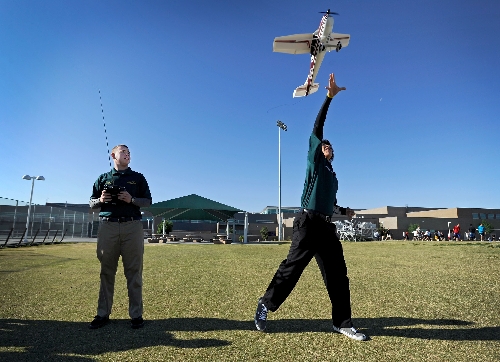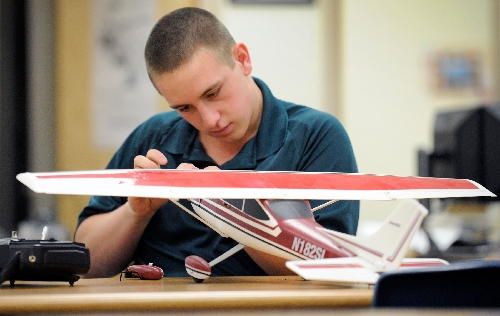Clark County high school students innovate in tech
Southern Nevada is becoming a hotbed of technological innovation.
One group of local inventors has drawn up plans for an electric-powered plane. Another cluster of creators drafted designs for an ecofriendly public bus. Still others have created video games. Some of the technologies are novel and patentable, with potential uses in broader industries.
But there's a catch: These innovators are high school students. And when they invent through the Clark County School District's science, technology, engineering and math (STEM) programs, the question becomes, who owns the rights to their work -- the kids or the district?
It's an increasingly common question, said Mark Tratos, an intellectual property attorney and a managing shareholder in the Las Vegas office of law firm Greenberg Traurig. Students are more interested than ever in high school science competitions, as both media attention and college scholarship money can flow from successful inventions.
"Students are looking at science fairs and student experimentation as a way to increase their overall attractiveness to college recruiters," said Tratos, who added the caveat that school budget cuts could cut the trend short if money for STEM initiatives dwindles.
In Las Vegas, students have developed groundbreaking ideas that could lead to pioneering products.
Take Gary Archambeault's students at Rancho High School.
Archambeault coaches teams entered in the national Real World Design Challenge, a contest sponsored by NASA and the U.S. Department of Defense, among others.
This year's team of seven students designed a lightweight, two-passenger plane capable of flying more than 500 miles. The plane would be powered by an electric motor that could run for as long as two hours using onboard photovoltaic solar panels. Along the way, the students designed their own wing, made from a Kevlar-epoxy composite, and a tail section, both of which could be patentable, Archambeault said.
The students will present their computer-assisted design and file a 527-mile flight plan later this month in Washington, D.C.
In 2011, Archambeault's team came up with plans for an aerodynamic public bus designed to use less fuel than existing buses. The front featured an angled surface, and the rear had an oval shape. The two components reduced drag on the bus by about 90 percent when compared with conventional buses.
A third Rancho Real World team has just started work on an environmentally friendly school bus.
The school district's public information office didn't respond to repeated e-mails and phone calls requesting comment on potential patents.
But Felicia Nemcek, the Southwest Career and Technical Academy principal who leads student programs to develop video games and apps, said the school teaches kids about intellectual property rights and patents.
Nemcek said the district does not have an intellectual property rights agreement in place should a student develop an app, but she began working with the district's legal department in December to explore whether such an agreement is possible.
"This is unmarked 21st century ground," she said. "There are no K-12 public institutions with an intellectual property rights agreement in place.
"Any policy that CCSD puts into place is to protect the kids, and we'd strive to create an ownership program that rewards and protects whomever created the app -- be it the kids, or the kids and teachers," she added.
Students in the academy's programs have yet to develop a patentable app.
Despite the patentable aspects of some of the Rancho students' technologies, Archambeault said there has been no discussion about copyrighting their work. He said there are "a lot of issues there."
For one thing, it would cost a lot of money to hire a patent attorney, an expense "that's probably prohibitive for our situation," he said.
Plus, there's the bigger question of who would own the rights -- the students or the school district.
The answer to that is simple, though, Tratos said. The rights belong to the students. U.S. patent law grants sole patent priority to the inventor. A school could try to prove that the students needed the district's labs or other facilities to create their invention and thus is entitled to a portion of the rights or proceeds from the technology's sale. But that would need to be part of a contract signed before the invention process began, and because kids under 18 aren't legally capable of agreeing to contracts, their parents would have to sign off on the deal, Tratos said.
So it might not make sense for schools to set up technology-transfer offices that are common for universities, which typically claim ownership of patentable creations invented by researchers who work for them.
Policies at the University of Nevada, Las Vegas give the school ownership of employees' inventions and the responsibility of protecting and commercializing the innovations. Researchers get 60 percent of products' net proceeds, a share the school has said is as high as any university offers.
Aside from the trouble with contractually binding students, it may not be worth the school district's while financially to chase down patent rights, Tratos said.
"I read the (intellectual-property) literature all the time, and I can't think of a single example of an invention by a high school student that has led to a large, financially profitable product out there in the marketplace that has generated large royalties for the inventor," he said. "That doesn't mean it won't happen. It just hasn't occurred yet. Only a small percentage of patents ever issued become lucrative successes."
Whether students attempt to obtain patents or not, they can protect their work now, Tratos said.
He recommends that all innovators and creators keep an "inventor's notebook," a standard laboratory portfolio that documents how an invention evolved. That creative trail is especially important given recent changes in federal patent law, which used to give patent rights to the first inventor, but which now reserves patent rights for the first person to file for protection.
As minors, students may have less of a legal right to file for patents, but keeping a journal of their processes, and perhaps even publishing some of their test results, can "put them in a priority position to secure a patent" later, Tratos said.
But it's not as easy as following federal law alone. Nevada law also has something to say about patent rights.
Tratos said the students' situation is also a reminder for employees of schools, universities and private businesses alike that, unless stated in a contract, your employer owns all of your work, based on a 2001 state law born of gaming-technology companies frustrated with employees taking ideas for new slot machines to competitors.
"Unfortunately, it puts us as a state in a really ugly spot," Tratos said. "I'm always cautioning people to look at what their contract says."
























